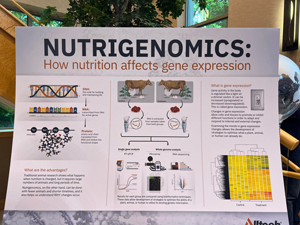
Written by: Victoria Broehm | June 3, 2022

There is a Ghanian concept, “Sankofa,” which loosely translates to: harnessing the knowledge people gained in the past to create opportunities for the future. I first heard about this phrase during the opening session at last week’s Alltech ONE conference and given the pressures currently facing consumers, farmers, governments, business leaders and society, it couldn’t be more perfectly timed.
How do we – as a food and agricultural community – learn from our past so that we can create a better world for future generations?
Heather White, author, founder and chief executive of OneGreenThing, explored this concept during her presentation, where she discussed that today’s youth have a chronic fear of environmental doom. She said the climate crisis has impacted their mental health, creating what has been coined “eco-anxiety,” where youth are experiencing generalized anxiety, chronic loneliness and a hyper-awareness of social issues. She said that one way to change this is for all of us to show how we are working individually to achieve big, positive change for the future.
“All of us are our ancestors’ wildest dreams,” White said. “We need to spread hope and change and show that progress is not only possible, but it’s inevitable.”
If only these youth could have heard from some of the conference’s line-up of speakers, I think they would have walked away with the central message I took away from the conference:
Progress in the agriculture industry is not only continuous, but it is relentless.

In fact, after two years of managing the coronavirus pandemic, I was expecting that many of the speakers at Alltech’s first in-person conference since 2019 would talk about projects put on hold or goalposts moved during this time, but instead, I was blown away by the research and progress on new technologies shared that had taken place over the past few years.
For example, in the “Delivering Value from Ag-Tech” workshop, I felt like I was on an episode of, “Shark Tank,” with several speakers sharing ways they are using data and technology to improve the feed manufacturing process and feeding practices on farms, detect animal health concerns and diseases, utilize novel feed ingredients and more. Some of this technology in development could potentially help farmers spot animal disease from behavioral changes days before an outbreak – which could be critical for managing outbreaks before they bubble into crises, like the recent African swine fever outbreaks in China and Europe or the highly pathogenic avian influenza outbreaks across the United States.
Early health detection changes the course of treatment in farm animals and has the potential to reduce antibiotics used, said Yasir Khokhar, chief executive and founder of Connecterra B.V. It can also help farmers reduce costs and better manage issues, such as heat stress, on farms ahead of time.
There are also emerging bodies of science that will push us – in a good way – outside of our comfort zones by better connecting human and animal nutrition with environmental science.
Since most of the conferences I recently attended were ones where I needed to work, I welcomed the opportunity last week to explore various sessions as a continuing education student. And I’m glad I did!

I learned two new (to me) words – nutrigenomics and neurogastronomy. The first, which I discovered while touring the Alltech research lab, looks at how nutrition affects gene expression, but can be done with fewer animals and shorter timelines than traditional animal nutrition research. The second is a recent (since 2006), yet growing, area of medical research, that examines how the human brain perceives flavor.
Dr. Dan Han, head of the division of neuropsychology at the University of Kentucky College of Medicine, during his session on neurogastronomy, asked the audience to ponder: if we could change how people perceive flavor, what possibilities would that bring for addressing hunger, crop science and growing foods that are better for people and the planet? By reaching “across the hall and getting out of silos,” we could unite the medical, nutrition and agriculture communities in achieving many shared goals, he said.
It really turned on its head how I think about the agriculture community achieving its dual goals of nourishing the present while preserving the future. I walked away from the conference feeling optimistic that my children will grow up in a world where their food tastes better, is grown from better land and healthier animals, and that their doctors will take a more holistic approach to their health, from the bottoms of their toes to the tips of their tongues.
These were just a few takeaways from the week, but all in all, it was a great week to listen to a variety of sessions examining current research and development in animal agriculture and nutrition, as well as an opportunity for me to cross another state – Kentucky – off my to-visit-someday-list. Next on my to-do list: watch the documentary, “Landfill Harmonic,” which showcases the Paraguayan musical group, which played during the conference, from musical instruments made entirely from recycled garbage.
Comments See our policy on comments